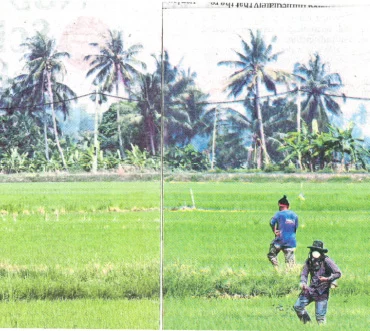NATIONAL PRIORITY: We must improve efficiency in use of water for agriculture to ensure continuous food production
FOR most of us, water scarcity means shortage of tap water. But, the amount of water for drinking and domestic needs is small compared with the volumes required for food production.
Some people may drink only two litres of water a day and use 30 to 400 litres for domestic needs. But they may consume about 3,000 litres daily if the water that goes into their food is taken into account.
Consequently, water withdrawals for agriculture are already greater than natural replenishment levels in many parts of the world such as Yemen, north-eastern China, southern Spain, and western United States. Water is likely to get scarcer as global warming worsens.
In 2007, seven hundred leading scientists collaborated to publish a 645page assessment report titled Water for Food, Water for Life. The authoritative study specifically asked, was there enough land, water, and human capacity to produce food for a growing population in the next 50 years. The answer was no, unless we act to improve water use in agriculture.
However, because the effects of water scarcity are gradual and local, the willingness of many central governments to respond to the agricultural water challenge has generally been weak and fragmented.
The classic textbook solution to solve problems of grain supply is to rely on global food trade.
But, the food crises in 2007-2008 and 2010-2011 were a wake-up call for countries to safeguard their food security by not being over-dependent on international markets for supply. Sharp increases in the price of food imports or supply interruptions could have significant socio-economic ramifications domestically.
Another solution is to snap up agricultural land in poorer nations to feed your own people. Between 2004 and 2009, Saudi Arabia leased 376,000 hectares of land in Sudan to-grow wheat and rice. In 2008, the Saudi government announced it was to reduce its domestic cereal production by U per cent a year to conserve its water. The hunger for land with water looks set to increase with more countries from the rich club purchasing or leasing foreign land to become their food growing provinces.
True to its image as an aspiring high income nation and a champion of a just international system, Malaysia has a different strategy to feed its own people as it marches towards 2020. Realising that climate change will have severe impacts on Asia’s key rice granaries such as the Mekong delta, Malaysia is aiming to increase its self-sufficiency level for rice from 71 per cent to 100 per cent by 2020.
The 11th Malaysia Plan sets the target for the agro-food sub-sector to grow at 5.4 per cent per annum with livestock, aquaculture and vegetable as the main contributors. The National Water Resources Policy 2012 clearly states that “the security and sustainability of water resources shall be made a national priority”.
The question is will there be enough water to grow enough food for Malaysians in the long run? The answer is yes and no.
Water availability is generally good because Malaysia receives about 3.5 times more rainfall than the global annual average with 2,940mm a year. This natural endowment together with massive investments in irrigation infrastructure in the last 50 years has put agricultural water at the service or” farmers and people.
If we are to meet the target for rice self-sufficiency, the country needs more irrigation infrastructure for the proposed four new granaries in Pahang, Sarawak and Sabah. Moreover, the existing irrigation systems are under-performing in some paddy granaries due to the increase in water losses and maintenance costs as well as wastage by farmers.
While aquaculture, livestock and vegetable farming are mainly rain fed, better irrigation can lead to higher yields by applying the right amount of water at the right time with the right quality.
Since the construction and maintenance costs will be worth billions of ringgit, Malaysia must treat irrigation as a business opportunity and not just a social good.
Just as we had constructed highways using the public-private partnership model, a viable option is for the government to build the irrigation and drainage system and let the private sector maintain and ensure its sustainability.
Today the competition for scarce water resources is a reality. Industrial and domestic use is growing relative to that for agriculture. And water for electricity generation is growing rapidly, too
Many river basins do not have enough water to meet all the demands, especially so when Perlis, Kedah, Penang, Selangor and Malacca are already categorised as water-deficit states.
“The exclusivity of systems designed for agriculture is gradually breached to support other sectors”, argues Datuk Mohd Adnan Mohd Nor, who is chairing the Water and Agriculture Task Force for the Academy of Sciences Malaysia. The irrigation system for the Muda Agriculture Development Authority (Mada) granary now supports flood management and water supply in Kedah. Similarly, the Bukit Merah reservoir operates not only to irrigate the Kerian granary, it is also under increasing pressure to provide higher volume of quality water for the arowana fish breeding industry.
Water and food are thus tied to one another fundamentally. On top of their’ physical relationship, economic systems intervene, whether through pricing schemes, politics, technology or shifting patterns of consumption.
Achieving national food security is not possible without the coordination of agricultural policy-making with other development sectors. Governing the water-food nexus is now imperative.
Article by Dr Hezri Adnan which appeared in New Straits Times, November 3, 2015.





